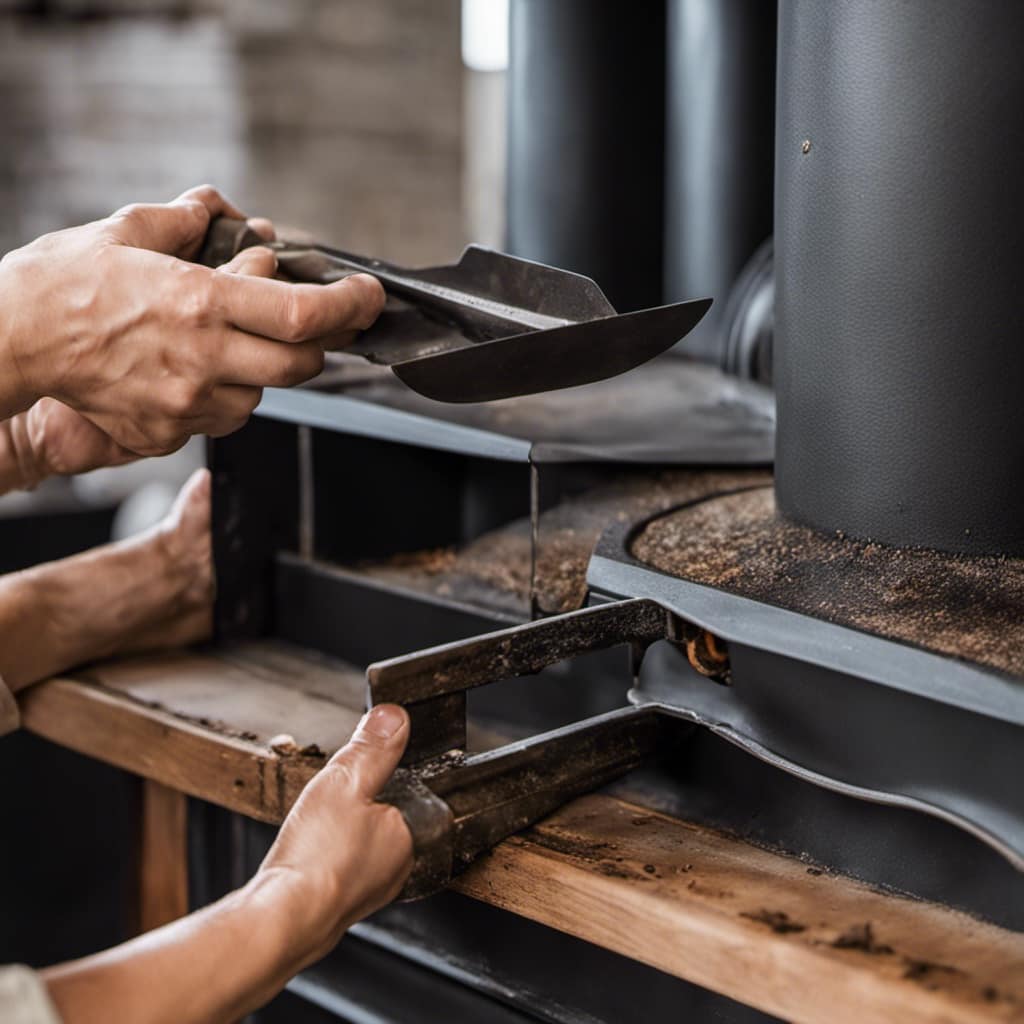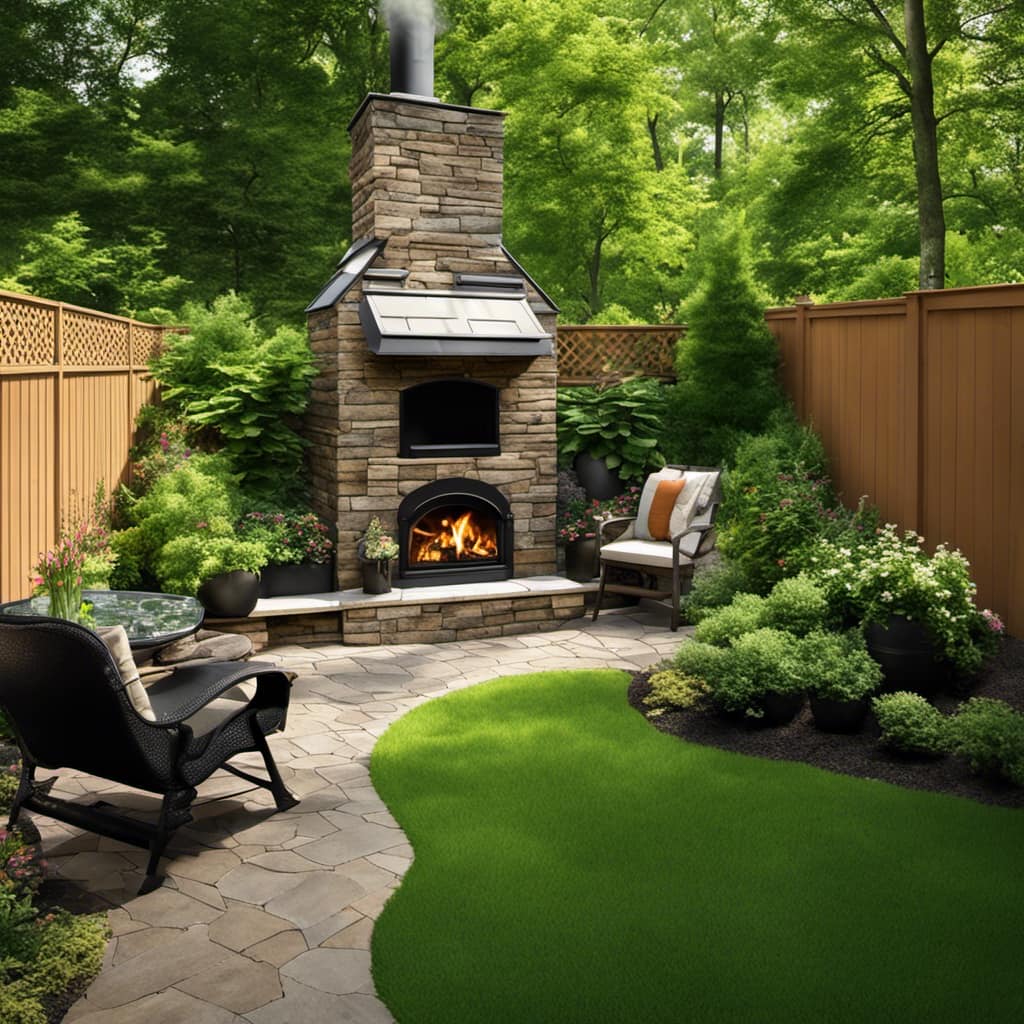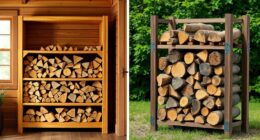Hello, fellow stove fans!
Are you tired of staring at that unsightly rust on your wood stove? Well, fear not! In this article, I’ll guide you through the steps to restore your beloved stove to its former glory.
From assessing the damage to removing the rust and maintaining its appearance, I’ve got you covered.
So grab your supplies and let’s get rid of that pesky rust together!

Key Takeaways
- Assess the extent of rust damage and identify potential sources of moisture.
- Choose an effective cleaning agent and gather all necessary supplies before starting the cleaning process.
- Prepare the wood stove by removing ashes and debris, wearing protective gear, and covering the surrounding area.
- Remove rust by scrubbing with a wire brush, applying a vinegar and water mixture, rinsing, and drying the surface. Consider applying a protective coating to prevent future rust.
Assessing the Rust Damage
I need to carefully inspect the wood stove to see how much rust damage has occurred. Evaluating rust severity is crucial in determining the best course of action for cleaning and restoring the stove.
I’ll start by examining the outer surface for any signs of rust, such as discoloration or flaking paint. Then, I’ll open the stove and inspect the interior, paying close attention to the firebox, grates, and any other metal parts.
It’s important to note the extent of rusting and whether it has caused any structural damage. Preventing future rust is equally important. I’ll make sure to identify any potential sources of moisture and address them accordingly.
Gathering the Necessary Supplies
Have you already gathered all the necessary supplies for cleaning the rusty wood stove?

When it comes to restoring a rusty wood stove, choosing the right cleaning agent is crucial. You want to make sure that the product you use is effective in removing rust without causing any damage to the stove’s surface.
There are several techniques you can employ to remove stubborn rust. One popular method is using a combination of vinegar and baking soda. This mixture creates a paste that can be applied to the rusted areas and left to sit for a few hours. Afterward, you can scrub the rust away with a wire brush.
Another option is using a commercial rust remover that’s specifically designed for stoves. These products often contain chemicals such as phosphoric acid, which dissolve rust effectively.
Whichever method you choose, be sure to take the necessary precautions and follow the instructions carefully.

Preparing the Wood Stove for Cleaning
To ensure a successful cleaning process, it’s essential to properly prepare the wood stove by removing all ashes and debris.
Before diving into the cleaning process, it’s important to understand the common causes of rust on wood stoves. Exposure to moisture and humidity is the primary culprit, as it promotes the formation of rust on metal surfaces. Additionally, neglecting regular maintenance and failing to address minor rust spots can lead to more extensive damage over time.
Therefore, it’s crucial to take precautions before cleaning a rusty wood stove. Firstly, ensure the stove is completely cool and disconnected from any power source. Secondly, wear protective gloves and eyewear to prevent any injuries. Lastly, cover the surrounding area with a drop cloth or newspaper to catch any debris or cleaning solutions that may fall during the process.
Removing the Rust From the Wood Stove
The best way to remove the rust from the wood stove is by using a wire brush and some vinegar. Rust not only affects the appearance of the stove but can also compromise its functionality. To effectively remove rust, start by scrubbing the affected areas with a wire brush. This will help loosen the rust and prepare the surface for cleaning. Next, create a mixture of vinegar and water, using equal parts of each. Apply this solution to the rusted areas and let it sit for about 30 minutes. The acidity of the vinegar will help dissolve the rust, making it easier to remove. Afterward, scrub the area again with the wire brush to remove any remaining rust. Finally, rinse the surface with clean water and dry it thoroughly. To prevent future rust, consider applying a coat of stove paint or using natural cleaning solutions like vinegar regularly.

| Pros | Cons |
|---|---|
| Effective in removing rust | Requires scrubbing |
| Uses natural cleaning solution | May require multiple applications |
| Affordable and easily accessible | Requires time to sit and soak |
Restoring and Maintaining the Wood Stove’s Appearance
I can keep the wood stove looking great by regularly cleaning and polishing it with a mixture of vinegar and water. This simple solution not only removes dirt and grime but also helps prevent future rust from forming.
Here are a few tips for caring for your wood stove and preventing future rust:
- Clean the stove regularly: Wipe down the surface of the stove with a damp cloth or sponge to remove any dust or debris.
- Use vinegar and water mixture: Mix equal parts vinegar and water in a spray bottle and spray it onto the stove’s surface. Then, wipe it clean with a cloth.
- Polish with a dry cloth: After cleaning, use a dry cloth to polish the stove, giving it a shiny finish.
- Keep the stove dry: Moisture can lead to rust, so make sure to keep the stove dry by wiping up any spills or moisture promptly.
- Apply a protective coating: Consider applying a heat-resistant paint or stove polish to provide an extra layer of protection against rust.
Frequently Asked Questions
How Can I Prevent My Wood Stove From Getting Rusty in the First Place?
To prevent my wood stove from getting rusty in the first place, I protect it by applying a high-temperature stove paint or coating. Regularly inspecting for any signs of rust and addressing them promptly also helps maintain its condition.
Can I Use Any Type of Cleaning Solution to Remove Rust From My Wood Stove?
Yes, you can use different cleaning solutions to remove rust from your wood stove. However, it’s important to consider the pros and cons of each solution to ensure safe and effective cleaning.

Is It Necessary to Remove All the Rust From the Wood Stove or Just the Visible Parts?
It’s important to remove all the rust from a wood stove, not just the visible parts. Rust can spread and damage the stove further. I’ll share techniques for rust prevention and effective removal on other metal surfaces and appliances.
Can I Paint My Wood Stove After Removing the Rust to Prevent Future Rusting?
Yes, you can paint your wood stove after removing the rust to prevent future rusting. It’s important to choose a high-temperature paint specifically designed for wood stoves to ensure durability and proper adhesion.
What Is the Best Way to Maintain the Appearance of My Wood Stove After Cleaning?
To maintain the shine of my wood stove, I can use products like stove polish or metal cleaner. To prevent discoloration, I should avoid using abrasive cleaners and regularly apply a protective coating.
Conclusion
In conclusion, cleaning a rusty wood stove is a simple yet crucial task to maintain its appearance and functionality. By following the outlined steps, you can remove rust and restore the stove’s appearance effectively.

Did you know that according to a study, rusty wood stoves can cause a decrease in heating efficiency by up to 25%? So, regular cleaning can’t only enhance the stove’s appearance but also improve its performance, making it a worthwhile endeavor for any wood stove owner.
Growing up surrounded by the vast beauty of nature, Sierra was always drawn to the call of the wild. While others sought the comfort of the familiar, she ventured out, embracing the unpredictable and finding stories in the heartbeat of nature.
At the epicenter of every remarkable venture lies a dynamic team—a fusion of diverse talents, visions, and passions. The essence of Best Small Wood Stoves is crafted and refined by such a trio: Sierra, Logan, and Terra. Their collective expertise has transformed the platform into a leading authority on small wood stoves, radiating warmth and knowledge in equal measure.











